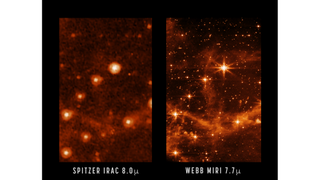NASA's James Webb Space Telescope is almost ready for science. Here's what's next.
The first science work for the $10 billion telescope should start in the early summer.

The days are ticking away before NASA's massive new observatory shows us the cosmos as we've never seen it before.
The James Webb Space Telescope is powering through a complicated six-month commissioning period. With just a few more weeks of work to go, NASA and its partners released an update Monday (May 9) previewing what comes next for Webb as it prepares to look at the early universe.
The good news is that so far, the $10 billion observatory is blowing expectations away as it enters a stretch of long-anticipated science work that mission personnel hope could last as long as 20 years.
"There's no adjustments in the telescope optics that would make material improvements or science performance, and we will regularly monitor and maintain the telescope alignment for the life of the mission," Michael McElwain, Webb observatory project scientist at NASA's Goddard Space Flight Center in Maryland told reporters Monday.
Live updates: NASA's James Webb Space Telescope mission
Related: How the James Webb Space Telescope works in pictures
But some key tweaks will be required in the next two months as engineers complete the final 200 or so activities (out of about 1,000 total commissioning steps) to get Webb ready for work. "We will characterize the performance of each science instrument mode well enough to know ho to take science quality data with it," McElwain said, adding that some of this work will continue through the early science period.
McElwain noted there are 17 scientific instrument modes that will come online in the next two months. A new tracker on NASA's main Webb website allows the public to track progress testing all 17 modes.
Get the Space.com Newsletter
Breaking space news, the latest updates on rocket launches, skywatching events and more!
"Each of those modes has different criteria that we're looking for; we want to see the performance is being met," McElwain said. "Each one of these modes will be reviewed independently," he added. "We'll have a board that will do the review."

Additionally, Webb's operational capabilities will be tested, most especially its ability to track objects within our own solar system, which move much faster in the telescope's view than distant objects as well as the observatory's ability to hold precise alignment as it changes targets. Additionally, wavelength calibration will be performed to make sure Webb is correctly recording the luminosity and spectra (a "fingerprint" of light that allows scientists to identify what elements are present) of its targets.
McElwain emphasized that the "static wavefront error," a metric concerning how well the observatory performs as it collects light from distant objects, is much better than engineers calculated before launch.
More simply put, the telescope is performing with better accuracy and position than expected.
"We're actually doing much better than requirements," he said.
Follow Elizabeth Howell on Twitter @howellspace. Follow us on Twitter @Spacedotcom and on Facebook.
Join our Space Forums to keep talking space on the latest missions, night sky and more! And if you have a news tip, correction or comment, let us know at: community@space.com.

Elizabeth Howell (she/her), Ph.D., is a staff writer in the spaceflight channel since 2022 covering diversity, education and gaming as well. She was contributing writer for Space.com for 10 years before joining full-time. Elizabeth's reporting includes multiple exclusives with the White House and Office of the Vice-President of the United States, an exclusive conversation with aspiring space tourist (and NSYNC bassist) Lance Bass, speaking several times with the International Space Station, witnessing five human spaceflight launches on two continents, flying parabolic, working inside a spacesuit, and participating in a simulated Mars mission. Her latest book, "Why Am I Taller?", is co-written with astronaut Dave Williams. Elizabeth holds a Ph.D. and M.Sc. in Space Studies from the University of North Dakota, a Bachelor of Journalism from Canada's Carleton University and a Bachelor of History from Canada's Athabasca University. Elizabeth is also a post-secondary instructor in communications and science at several institutions since 2015; her experience includes developing and teaching an astronomy course at Canada's Algonquin College (with Indigenous content as well) to more than 1,000 students since 2020. Elizabeth first got interested in space after watching the movie Apollo 13 in 1996, and still wants to be an astronaut someday. Mastodon: https://qoto.org/@howellspace
Most Popular

